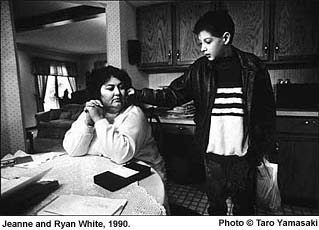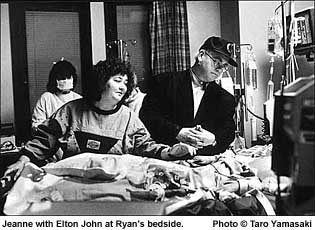|
TARO YAMASAKI,
former artist-in-residence at the University of Michigan School of Art
and Design, is a photographer for People whose documentary work
on social and medical issues includes photo essays on the life and death
of teenager Ryan White:
For years, the staff of People magazine had been trying to publish
a piece on AIDS, without success. It was a real travesty that we hadn’t
done a story much earlier. But it was finally decided, in the summer
of ’87, that we were going to do a 24-hour look at people with
AIDS. (People, August 3, 1987.) Photographer-reporter teams were
dispatched across the country, and writer Bill Shaw and I were assigned
to spend a day with Ryan White. His family had recently been hounded
out of Kokomo, Indiana, because Ryan, a hemophiliac, had contracted
this new, dread disease. He had been expelled from school. He fought
it in court. He won. He was allowed back in. And he would walk down
a totally crowded hallway in the school and people would run and hug
the opposite wall. He would have horrible things written on his locker.
Kids would move their desks away from his.
He finally decided that he did not want to die in Kokomo. He couldn’t
bear the idea of being buried there. So he moved to Cicero, a much more
tolerant town in the same state. I believe that Elton John helped his
family with the down payment for the new house.
We met Ryan, then 15, right after he moved in. It was a very humid,
90-degree day in July. We walked into Ryan’s house and it was stifling.
He was 55 pounds or so, this tiny person whose growth had been stunted
by the hemophilia and then by the AIDS. And he had a blanket over him.
He’d go over to the stove, turn it on and warm his hands.
He was very, very shy and very suspicious of us. He had had many unpleasant
dealings with the media. He felt like he had been at the center of a
freak show. On the other hand, he felt that it was important for people
to start learning what AIDS was really about - - how you got it and
how you didn’t.
We were low key. I didn’t even take my cameras out for the first
four hours. We weren’t going to do anything that made him uncomfortable.
We ending up spending the whole day, and Ryan ended up being on People’s
cover.
 Soon,
we found ourselves invited to document Ryan and his family, off and
on. Within months, his life would be totally transformed. His doctor
said it was not because of the medicine but possibly because of the
love he was given. His neighbors started knocking on his door, saying,
‘’Welcome to Cicero.’’ The superintendent held an
all school assembly before Ryan arrived, insisting, ‘’We will
not treat Ryan White like the people of Kokomo did.’’ The
everyday contact of his peers was now supportive. People readers
wrote to him, saying how much they admired what he was doing. When writer
Bill Shaw and I went back again, eight months after our first story,
Ryan had become much less guarded. He had gone from being the outcast
to being someone who was respected had made a tremendous difference
in his life. Soon,
we found ourselves invited to document Ryan and his family, off and
on. Within months, his life would be totally transformed. His doctor
said it was not because of the medicine but possibly because of the
love he was given. His neighbors started knocking on his door, saying,
‘’Welcome to Cicero.’’ The superintendent held an
all school assembly before Ryan arrived, insisting, ‘’We will
not treat Ryan White like the people of Kokomo did.’’ The
everyday contact of his peers was now supportive. People readers
wrote to him, saying how much they admired what he was doing. When writer
Bill Shaw and I went back again, eight months after our first story,
Ryan had become much less guarded. He had gone from being the outcast
to being someone who was respected had made a tremendous difference
in his life.
The impact of that first story was significant. A major magazine was
addressing the topic of AIDS head on. The pictures showed really sick
people. It was not reassuring. But it came across in an open, sympathetic
and honest way. The pictures said that people with AIDS were human beings.
And one of the reasons I work for People magazine is because
if there is any segment of the country that need to know about these
issues - - Middle America, the audience that People hits. Anyone,
gay or straight, rich or poor, of color or not, could look at those
pictures, feel what Ryan was going through, and make that jump, that
this could be my kid, my brother, my sister, my parent.
After our second story, Ryan and his mom, who had been extremely reluctant
the summer before, said that they felt happy with their decision to
open up and be in People. It had made a tremendous difference
in their lives because it helped others see them as they were, rather
than as pariahs. And you could see that in the pictures. Ryan playing
with his dog. Ryan with his good friends playing pool. Ryan hugging
his mom. The two of them praying at bedtime.
We did a story on his mother Jeanne’s trials. We spent a lot of
with Ryan. We traveled with him to Omaha, where he got the keys to the
city. We were getting to be friends, all of us. Ryan was named one of
People’s 50 most beautiful people. But his health, by 1990,
was getting progressively worse. And I got a call from Jeanne. ‘Ryan‘s
dying. You and Bill are the only journalists who are going to be in
the intensive care unit with us. Please come as soon as possible.’’
We rushed to Indiana.
 There
must have been 75 journalists downstairs in one of the waiting rooms.
Ryan was a huge story by then. Ryan was in a coma when I got there.
He never regained consciousness. Jeanne said, ‘’Please don’t
photograph Ryan’s face, I don’t want to remember him like
this.’’ He was very swollen. And that’s why the photograph
you see of Jeanne and Elton John, at Ryan’s bedside, does not include
Ryan from the neck up. We were there for maybe nine days and Elton John
was there the entire time. Elton was really taking care of the family.
He was sorting the mail. He’d come in with a sack full of toys
he would distribute to other kids in the intensive care unit. There
must have been 75 journalists downstairs in one of the waiting rooms.
Ryan was a huge story by then. Ryan was in a coma when I got there.
He never regained consciousness. Jeanne said, ‘’Please don’t
photograph Ryan’s face, I don’t want to remember him like
this.’’ He was very swollen. And that’s why the photograph
you see of Jeanne and Elton John, at Ryan’s bedside, does not include
Ryan from the neck up. We were there for maybe nine days and Elton John
was there the entire time. Elton was really taking care of the family.
He was sorting the mail. He’d come in with a sack full of toys
he would distribute to other kids in the intensive care unit.
That entire week was pretty remarkable for me. I wasn’t just a
photographer, but a friend caught up in a story. When Ryan died, everybody
went into his room and held hands around the bed. I was in there with
a camera. And Jeanne said, ‘’Taro, you can take the picture
or you can join us.’’ And I put my camera down and I joined
the circle. I knew that was an important picture. I knew that it was
a moment I should ‘get.’ But I also knew that the reason I
was in there in the first place was that they were not thinking about
me as a photographer and I was not relating to them as a photographer.
I knew I was going to wish I had taken that picture on some level but
I just felt like I had to join that circle.
The experience really made me think a lot about my humanity, the importance
of the pictures I take, the role photographers can play as educators.
That’s basically what photojournalists do: They experience something
and then they communicate it, in still images, to a larger audience.
But I really believe that I’m also educating myself. And I guess
there are certain things more important than ‘getting the picture.’
There’s a relationship with the circumstances and the individuals
and their interplay around you. And it became very clear to me that
there are certain things that I can’t photograph. I don’t
have that killer instinct. Yes, I’ve gone through hell to get some
pictures. But on the other hand, this is a picture I passed up. And
I would do it again.
I was just in Croatia last summer doing a story on this summer camp
for kids in war zones that brings Croatians, Serbians and Bosnians children
together. Volunteers from all over the world were there. And there was
a teacher from Connecticut. She heard I was from People magazine.
She met me and she asked, ‘’What is the most important story
you’ve ever done? What hit you the hardest on a personal level?’’
I thought a while and answered, ‘’The stories I did on Ryan
White.’’
She said, ‘’I knew you were that photographer. I just knew
it.’’ She was a young teacher just starting and she said that
when she was a teenager in Connecticut, she had read all those stories.
She had cut them out. She had put them in a book. She had framed one
of those pictures of Ryan. She said that it was Ryan’s story that
had inspired her to give more of herself to other people. She said she
had this picture of Ryan, from that story, on her dresser at home and
that the only reason she didn’t have it with her there was that
she just couldn’t bring everything she wanted in her luggage. That
really hit me. Here we were in Croatia and this person I had never seen
before in my life had been affected by Ryan White and my photographs
of him. It crystallized, for me, the power of photography to connect
with people, in lasting ways, about themes of real significance.
Visit
the Elton John Aids Foundation:

|